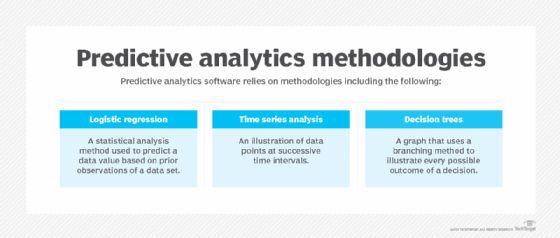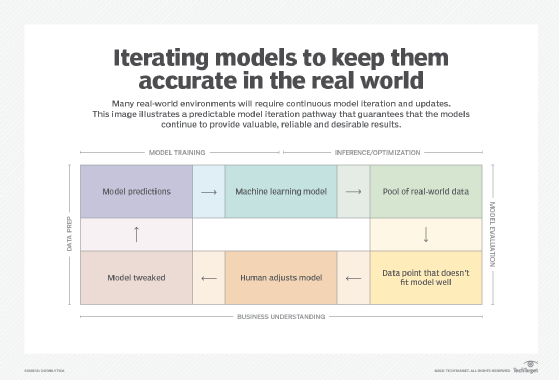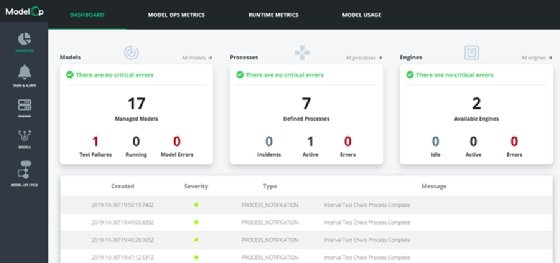What are ModelOps (model operations) analytics models?
ModelOps (model operations) is a holistic approach to building analytics models that can quickly progress from the lab to production. An important focus of ModelOps is to automate the deployment, monitoring, governance and continuous improvement of data analytics models running 24/7 within the enterprise.
ModelOps is a DevOps variation. While DevOps focuses on application development, ModelOps is designed for data analytics.
ModelOps mirrors DevOps practices for ensuring regulatory compliance, security and manageability. It's crucial for predictive analytics at scale and enables the continuous delivery as well as smooth and efficient development and deployment of models.

With rapid machine learning (ML) and artificial intelligence (AI) adoption, analytical assets and models are multiplying at a fast pace. Although many organizations acknowledge the growing importance of a data-driven culture in their continuing digital transformation, applying changes based on the interpretation of data sets is challenging.
Organizations often struggle with the final stages of "implementing, operationalizing and putting analytics to work," said Dan Vesset, group vice president of analytics and information management at IDC. As model development becomes more prevalent for solving business problems, deployment and model governance are often the last hurdle.
How does ModelOps work?
According to research firm Gartner, ModelOps primarily focuses on the governance and lifecycle management of all analytics, AI and decision models. These include analytical and ML-based models, knowledge graphs, rules, optimization, linguistics and agents.
In a real-world application, the ModelOps team helps foster communication between data scientists or data science teams, data engineers, application owners and infrastructure owners. They also monitor model deployment and coordinate proper handoffs and execution so that models can advance to the so-called last mile.
Workflow automation, version management, promotions, compute resource management, monitoring, scaling and tuning are among ModelOps responsibilities.
Monitoring the effectiveness and performance of a ModelOps program and algorithms is crucial. ModelOps involves development, testing, deployment and monitoring -- all of which can be effective only if model management is ensuring the scale and accuracy an organization needs.
As the models degrade, they need to be adjusted and redeployed. Performance parameters include the following:
- Set up and track accuracy goals for models through development, validation and deployment.
- Identify business metrics affected by the model in operation. Determine if the model is having the intended effects.
- Track metrics such as data size and frequency of update, locations, categories and types. These metrics can help determine if model performance problems are a result of changes in the data and its sources.
- Monitor how much computing resources or memory models consume.

Elements of a ModelOps approach
ModelOps stimulates dynamic collaboration and improves productivity for analytics and IT operations teams. It does this no matter which programming language is used, which data is accessed or where the model is deployed.
To bring analytics from the lab into use, a ModelOps framework does the following:
- Accesses data from a trusted source.
- Maintains privacy and security standards.
- Keeps a development environment and deployment scenario in mind when creating models to limit the amount of extra work needed.
- Retains data lineage and track-back information for governance and audit compliance.
- Accomplishes ModelOps rapidly while ensuring close collaboration between data scientists and IT.
- Focuses on monitoring when deploying models, retraining them as they degrade.
There are several business use cases for ModelOps, including software engineering, retail, finance and healthcare.

Benefits of ModelOps
ModelOps can help companies that face increasing challenges in scaling their analytics to move AI and ML models from the data science lab into IT production. ModelOps provides regular updates and deployments as these models are managed, scaled, monitored and retrained to push them into production. This translates into business value to the organization.
Other benefits of ModelOps include the following:
- Predictive capabilities that provide significant time and money savings.
- Improved decision-making and accelerated model deployment.
- Deviation correction from a defined baseline and provision of real-time analytics.
- Identification of patterns and insights that tie business key performance indicators to model outcomes.
- Cloud integrations to help make AI models more economical.
Challenges of ModelOps
ModelOps teams face several challenges with its implementation and execution. The most common are the following:
- Data versioning. A lack of constant data versioning can affect model performance, as data continually evolves.
- Data discrepancy. Data used by ModelOps must come from multiple sources, which can lead to discrepancies between data formats and values.
- High costs. Significant costs are involved with the deployment and use of ModelOps, including the investment of time and the hiring of ML data scientist talent, which is in high demand and expensive.
- Security. ModelOps often involves highly sensitive data that if stored in insecure or outdated libraries can be accessed and breached.
ModelOps use cases
ModelOps has several use cases across multiple industries. Some of the most important include the following:
- The healthcare sector uses ModelOps for disease diagnosis and treatment prediction.
- The financial industry uses ModelOps to monitor and optimize models for fraud detection and risk assessment.
- The retail sector uses ModelOps for demand forecasting and personalized recommendations.
- The transportation industry uses ModelOps to optimize logistics operations, improve route planning and enhance fleet management.
ModelOps best practices
A large portion of the potential value generated by analytics and enterprise AI initiatives could be lost if analytical models aren't pushed into production. However, inefficiencies in the process cause many analytics models to never make it to the last mile. Some of the technical challenges organizations face in deploying a model into production include the following:
- The analytics model must be compatible from the creation environment to the production environment. An agnostic scoring engine designed to take models created in any language and deploy them into production can help address the challenge of model compatibility across the model lifecycle.
- The model must be portable. Docker and other container technologies can help solve the application portability challenge by capturing the environmental dependencies for the analytic workload, providing a portable image.
- Monolithic and locked-in platforms may limit what organizations can do or offer services companies don't need. However, containerization technologies can help organizations use native microservice software to address changing needs and limit service failures to isolated components.
- As the model progresses to production, it's typically exposed to larger volumes of data and data transport modes. The application and IT team will need tools for monitoring and solving performance and scalability challenges. Adopting a consistent, microservices-based approach to production analytics can help solve scalability challenges.
ModelOps vs. MLOps
ModelOps and machine learning operations (MLOps) are similar terms that focus on distinct aspects of managing ML implementation. ModelOps is an approach that encompasses the governance of the entire ML lifecycle, from development to deployment and ongoing model monitoring. Besides lifecycle management, it also includes the management of other AI decision models such as knowledge graphs and natural language processing.
A key function of ModelOps is keeping machine learning models updated and addressing challenges such as data drift. It also incorporates preventive measures to keep projects on track and promote standardization for scalable and reusable models.
MLOps is a subset of ModelOps that deals only with the ML models. Its focus is limited to the operational aspects of deploying models into production environments, ensuring they're maintained, monitored and updated effectively. This includes handling model versioning, scaling, ML engineering and compliance with regulatory standards, all of which are crucial for the long-term performance and reliability of the deployed models.
MLOps focuses on creating a streamlined, collaborative workflow that facilitates continuous integration/continuous delivery of ML models. It aims to improve the efficiency and scalability of ML projects by automating repetitive tasks, managing data pipelines and ensuring seamless collaboration between IT operations teams and data scientists.
ModelOps is a critical component of predictive analysis. Discover the top predictive analytics tools.







